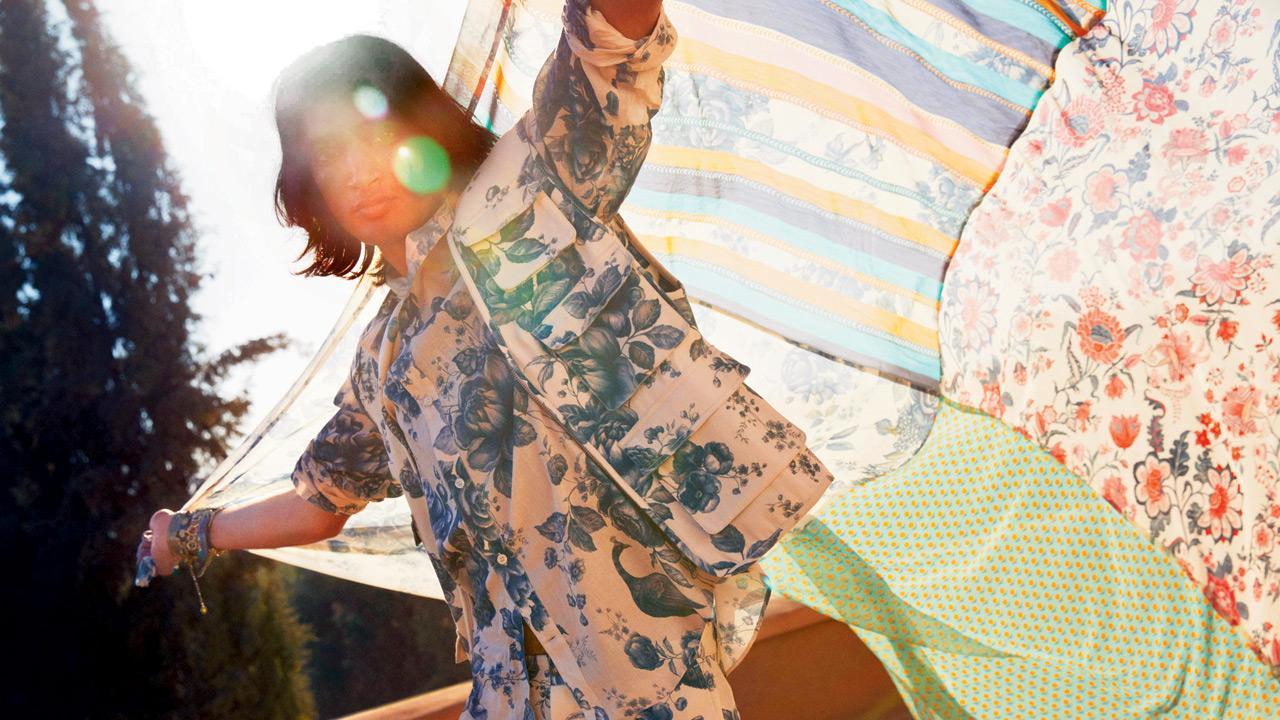Sabyasachi Mukherjee is the first Indian designer to collaborate with H&M on a pret line that establishes a meeting ground for clothing cultures as Mukherjee introduces denim jeans for the first time and the Swedish retailer, a saree

Seventy-five per cent of the Wanderlust collection includes size-agnostic, gender-fluid styles like the lounge coat, kaftan, kurta, denim jean, safari jacket, shorts, shirts and T-shirts
The first garment Sabyasachi Mukherjee, 47, wore was a frock. “I think my mother had hoped for a girl when she had me,” he says with a straight face. “So, I wore frocks and jewellery until I was nearly three. I was a happy victim of role-play.” This off-the-cuff comment underlines Mukherjee’s current mood, which is to democratise fashion.
But how does a high-end brand, revered for its desirable trousseau and fine jewellery, actually democratise fashion? The short answer is Wanderlust, a travel-inspired limited-edition prêt collection of clothes and accessories imagined and designed by Sabyasachi Mukherjee for H&M.
Soon you can afford a Sabyasachi saree (Rs 9,999) which will be available at H&M India. “The saree’s pallu depicts an old lithograph of erstwhile Calcutta while its border is inspired by Kutch embroidery,” Mukherjee says
It’s egalitarian in its affordable price tag; everything is available under Rs 9,999. Mukherjee says the idea behind collaborating with the Swedish clothing company was to introduce a ready-to-wear line of classics for people who want to buy the brand but did not have access to it. “Fashion is global and local at the same time. India is a super important market for us, and we are thrilled to work with creative talents like Sabyasachi,” says Maria Gamzell, head of new development at H&M. The retailer’s past collaborations include capsule collections with international luxury houses like the late Karl Lagerfeld, Lanvin, Balmain, Stella McCartney, and the queen of pop Madonna.
It’s inclusive in its designs and sizes; seventy-five per cent of the collection includes size-agnostic, gender-unspecific classic styles like the lounge coat, kaftan, denim jean, safari jacket, shorts, shirts and T-shirts featuring the brand’s signature Bengal Tiger logo. Women and men can buy products from each other’s section, mix and match, repurpose, and not worry whether it would be relevant in 2027. “Fashion mirrors life, life does not mirror fashion. Human beings are the happiest when they are themselves, but there is so much social pressure and repression; so if clothing can be a tool for people to break barriers and express themselves, like beauty, then why not?”
Why is it important for Sabyasachi Mukherjee to talk about gender inclusivity?
I am quite surprised by the younger generation and their openness to understand and use correct gender pronouns. They are growing up to be an accepting society that does not discriminate between sexuality and gender. For them, people are human beings first. I think the older generation that has been so prejudiced can learn the merits of tolerance from them. We are at a healthy time in our life when there is a discussion between generations, which will probably help us shape a better world. This also makes inclusivity an important dialogue to have with clothes.
Sabyasachi Mukherjee
Tell us about your infatuation with pop icon Madonna.
Growing up middle class in the suburbs of Calcutta, I used to own a Walkman, and one day, I walked into a music shop to buy a new cassette. But they had only two albums, Madonna’s Like a Virgin and Michael Jackson’s Thriller. At the time, I was just like any another teenager with raging hormones, discovering my sexuality, and the term ‘virgin’ on the album cover felt erotic. Ever since that introduction, Madonna has become a big part of my universe. It’s funny how when I was at my lowest during the pandemic because we had lost a lot of people we knew, I woke up one day and saw Madonna following me on Instagram. I am also kicked about the fact that H&M has a Sabyasachi T-shirt beside a Madonna T-shirt.
What does it mean for you personally to be the first Indian designer to collaborate with H&M?
A collaboration with H&M is like a lifetime award because they only approach you when your brand becomes a power story in a certain geography or in an emerging market. During our first meeting, I asked them only one question: Why me? And their response, “Because I am so Indian”, made me smile. Sometimes, you don’t do a collaboration for business but because you want to tell the India story on your own terms, the narrative of the land with embroidery and print. I hope design students realise the importance of having a global voice while taking pride in their Indian identity. This collection by an Indian brand will be stocked in stores across the world. Finally the world will recognise India — as a market it’s unshakeable and as big and important as China.
Wanderlust goes on sale on August 12, 11 am onwards on Myntra and H&M online platforms, and at physical stores in India, except Mumbai
 Subscribe today by clicking the link and stay updated with the latest news!" Click here!
Subscribe today by clicking the link and stay updated with the latest news!" Click here!









